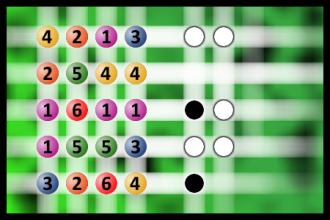What a winning combination?
The computer chose a secret code (sequence of 4 digits from 1 to 6). Your goal is to find that code. Black circles indicate the number of hits on the right spot. White circles indicate the number of hits on the wrong spot.Correct answers: 51
The first user who solved this task is James Lillard.
#brainteasers #mastermind

A new apartment...
Having been married ten years and still living in an apartment, the wife would often complain about anything, as she was tired of saving every penny to buy a "dream home".
Trying to placate her, the husband found a new apartment, within their budget. However, after the first week, she began complaining again.
"Johnatahan," she said, "I don't like this place at all. There are no curtains in the bathroom. The neighbors can see me every time I take a bath."
"Don't worry." replied her husband. "If the neighbors do see you, they'll buy curtains...."

